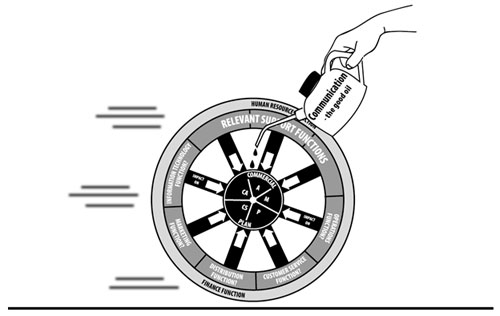2.6.2 Communication - The Good Oil!
Last month’s article looked at the five ingredients of successful execution:
- Organisational alignment
- Change management
- Leadership
- Employee engagement
- Teams and Teamwork
These factors lie at the heart of a company’s ability to translate business strategies into action. The catalyst is communication – the good oil.
Implementation represents the fourth stage in the Wagon Wheel business model. Preceding it have been Stage 1 – developing the Commercial Plan; Stage 2 – assessing the implications of the Commercial Plan on the Support Functions and thirdly their impact on the two key Enabling Functions of Human Resources and Finance.
The Wagon Wheel is now ready to roll
Friction between the wheel and the road is essential if the Commercial Plan is going to gain traction. In contrast, internal friction between the hub and the axle is highly undesirable. And what reduces friction in the Wagon Wheel - and your organisation - is Communication – the good oil. A previous article – “How do you make your staff feel?” - focused on the selection of communication media. This one focuses on the communications content in the context of the five implementation factors listed above.
Organisational alignment
There is a saying that the more people you use to plan the battle, the less there are to battle the plan. The truth of this axiom can be demonstrated by reference to bpi’s Employee Feedback Surveys. In the section of the survey addressing “Decision-making & Participation”, there are three statements that read as follows:
- We are sufficiently informed about decisions that affect us
- We are sufficiently consulted by decisions that affect us
- We are sufficiently involved in decisions that affect us
What we consistently find is that a) the average rating indicates disagreement with all three statements and b) the last statement has the lowest agreement rating of the three.
So in the first instance involve as many people as is practical and desirable to develop the Plan initially and then summarise and communicate that plan to all those that will be involved in its execution. Do not confine the communication to the objectives and the strategies to achieve them. You must also explain the rationale behind them and the role that each member of staff is to play in the Plan’s execution.
Organisational alignment is the basis of effective implementation. Everyone needs to understand the current reality, be assured that the organisation knows where it is headed, how it’s going to get there and his or her role in the journey. If executive management cannot articulate this, it needs to go back to the first three stages of the Wagon Wheel model.
Change management
I have written this many times before but 70% of people will change given a convincing enough reason to do so. Only 5% will actively resist change and will in all probability leave the company if the train pulls out of the station without them. To affect “permanent” change among the 70% (the other 25% will embrace change), requires effective communication, explaining the circumstances that have led to the necessity for change and the nature of the changes themselves.
Communication has to be sensitive but at the same time honest. Staff will strip the spin from communications quicker than you can put it on. There is one further, vital communications task. That’s to keep staff informed of progress and to publicly acknowledge those who have supported the changes by their actions.
Leadership
Good leaders make meanings for people. They communicate as much through listening as they do by telling. They understand better than most the maxim that actions speak louder than words. They understand the importance of visibility and accessibility.
In contrast to the macro communications of organisational alignment and change management, leadership – when it is practiced at all levels of the organisation – is largely about micro communications – communications between individuals. In addition to the communication tasks outlined under the previous two headings, the leader is always seeking feedback from his or her reports – how can we do it better and how can I help you make your job more satisfying than it is now.
Employee engagement
Numerous studies have been conducted to establish what motivates people at work. The results are by no means consistent but some general conclusions may be drawn. Extrinsic satisfiers such as adequate pay, work safety and health must be present but the key motivators tend to be intrinsic factors such as being kept updated about the “big picture”, being recognised for good work, being involved in decisions and decision-making that directly impacts that individual and being treated with respect. Although the need for macro-communication still exists, micro-communication plays the larger part.
Teams & Teamwork
Our definition of a high performance team is as follows:
“A team is a small number of highly communicative people with complementary skills who are committed to a Common Purpose, Goals and Approach for which they hold themselves mutually accountable”
But it is not just communication within teams that makes a good team. Communication between teams is just as significant because all teams – or workgroups – have their own internal customers and suppliers.
Communication - conclusions
One would imagine that with so much hanging on good communications that organisations would spend an inordinate amount of time making sure that these communication tasks were effectively carried out. Sadly that’s not the case. All too frequently, a good business strategy is compromised by poor implementation which, in turn, is caused by inadequate communication.
There is a very high probability that Communication and Participation in Decision-making will fetch up in the last two places out of the nine factors measured in our Employee Feedback Surveys. Here are some typical comments from an employee survey. Each respondent was asked to give his or her ideas for improving job satisfaction:
- Better communication from the top down
- More communication on management direction from management. More information on R&D and what is being worked on
- Communication – little communication between teams on issues that may affect others
- Great place to work – friendly people but communication could be improved
- Communication throughout the country could be better – I am often left in ignorance about the goings-on with customers I deal with
- I’d like people to respond to my e-mails promptly, follow up on requests for information and communicate better in general
- There is much frustration about many aspects of the company due to lack of communication.
A whopping 64% of respondents included Communication in their list of things that this company needed to improve to enhance job-satisfaction among employees – and organisational performance.
So in summary, here is a list of key communication tasks:
- Task No.1 – Everyone needs to know where the organisation is now, where it is headed and how it intends to get there
- Task No.2 – Everyone needs to appreciate his or her role in the execution of the strategy
- Task No.3 – Everyone needs to be kept up to date with progress
- Task No.4 – Leaders at all levels of the organisation must walk the talk, engage in two-way communication with their reports, recognise and reward good work and set the standard they wish others to emulate
- Task No.5 – Enhance teamwork by formalising communication between workgroup members and between different workgroups. Good formal communications lead to even better informal communications.
The more you can involve staff in Communication Tasks 1 & 2 as opposed to informing and consulting, the better the outcome and the less the friction when it comes to implementation.
Finally always remember that actions speak louder than words. Be visible – particularly in the hard times.





